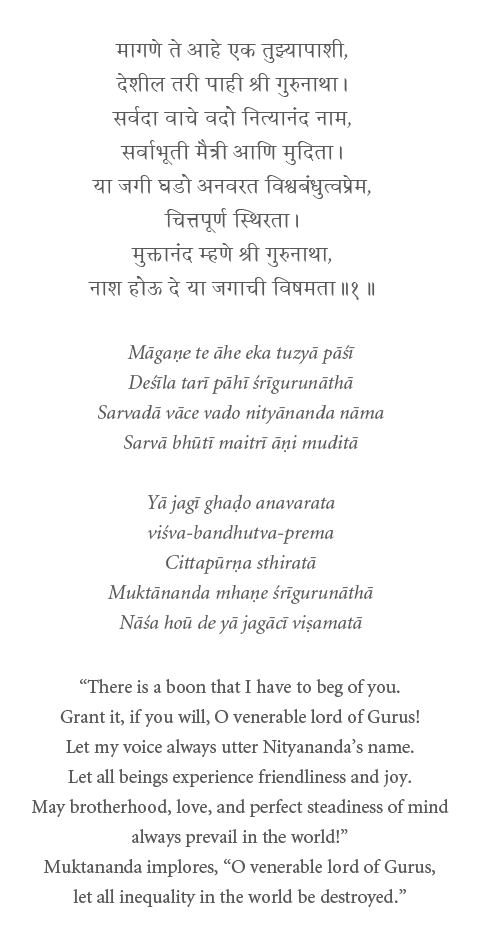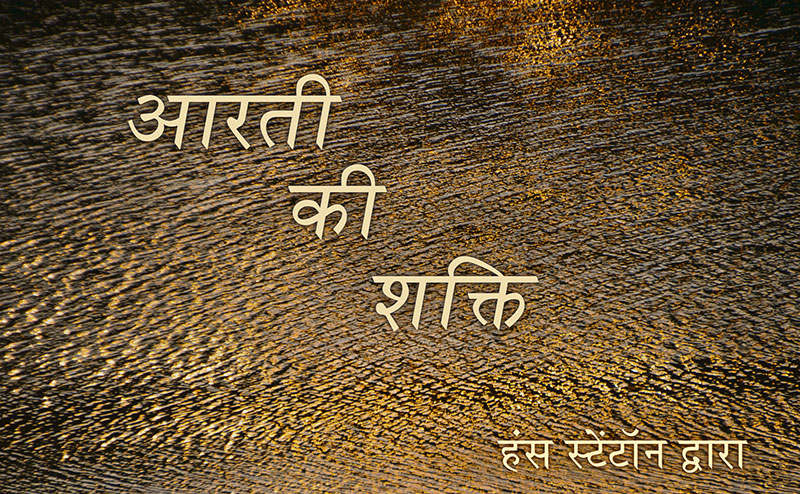In Step with the Heavenly Beat
An Account of Gurumayi’s Birthday Celebration
Shree Muktananda Ashram
June 23 – 24, 2015
Part V

The graceful worship continued as we all rose to our feet to participate in the Evening Arati in the Temple with Gurumayi.
Traditionally in India, dawn and dusk are called sandhya, a time of transition, when it is neither day nor night. Gurumayi and Baba have taught us that each sandhya is a time of heightened spiritual potential, when worship bears great fruit. For this reason, the Morning and Evening Arati has been part of the Ashram Daily Schedule ever since it was established by Baba in 1966 in Gurudev Siddha Peeth.
The Morning and Evening Arati begins with the playing of instruments for an extended period of time while the arati lamp is waved. The triumphal sound of the instruments is said to awaken and beckon the deity of worship. As the sound builds, in step with the heavenly beat, it also awakens and invigorates our whole being, frees our mind from the grip of negativities, and supports us to focus on our true nature.
The traditional instruments played by participants in the arati include a large bass drum, several damarus (hand drums), bells, cymbals, and the sacred shankha (conch). The sounds of these instruments represent forms of nada, the inner sounds that arise during meditation from the movement of the awakened Kundalini Shakti. The sounds touch different chakras within the human body, purifying these spiritual centers.
The arati instruments also echo the elemental sounds of nature. The sound of the shankha is like the ocean, the water element; it stills the mind. The sound of the rumbling drum resonates with the earth element; it strengthens the heart. Bells evoke the wind, while the ringing cymbals are like scintillating light. All these sound vibrations purify the mind and the elements of the body, preparing one’s entire being for worship.
 This was the first time I had heard Gurumayi play the tambourine during the Arati!
This was the first time I had heard Gurumayi play the tambourine during the Arati!As the instruments resounded throughout the Temple and beyond, I felt that the deities and great beings everywhere were being drawn to this sacred space. Their benevolent presence was tangible.
The swelling sounds of the instruments reaching their crescendo signaled the conclusion of this glorious invocation and the waving of lights.
Carrying the lamp, the pujari walked slowly to the murti and placed the lamp right before Bade Baba. The beautiful flames made his golden form shine even more radiantly.
 The Morning and Evening Arati in Siddha Yoga Ashrams is an immensely powerful practice. I could experience the power of arati vibrating throughout my being, from the tips of my toes to the top of my head.
The Morning and Evening Arati in Siddha Yoga Ashrams is an immensely powerful practice. I could experience the power of arati vibrating throughout my being, from the tips of my toes to the top of my head.This magnificent arati is a compilation of scriptural verses in Marathi and Sanskrit especially chosen by Baba Muktananda. The Arati is a stirring invocation of Shri Guru as well as a treasury of yogic wisdom. Its verses teach us about the nature of the Guru—as the supreme power of Consciousness that is our own Self, and as the One who dwells in every aspect of creation.
By reciting this arati, we glorify Shri Guru as embodied in the divine beings, the immortal sages, and the unbroken lineage of Siddha Gurus going all the way back to Lord Shiva, the Adi-Guru, the primordial Master.
To form the opening of the Arati, Baba composed several verses in Marathi.
The refrain of this opening section glorifies Bhagavan Nityananda:

In the first verse we sing:

As I concentrated on reciting the verses of the Arati with their diverse melodies and rhythms, with their rich Marathi and Sanskrit phrasing, my stance became strong, like a mountain, and my mind became quiet, focused, and present.
After singing the Arati, we sat in stillness, bathing in the power of the sounds, the flames, and the mantras. Bade Baba was surrounded by the most gorgeous lotus candles. The candle flames flickered, and our hearts shone with gratitude. This was one of those auspicious moments when the heart makes a promise; it then becomes the job of the mind to remember this promise and carry it to fulfillment.
After we had sat quietly for a few moments, Gurumayi asked Meera, “Has the sun set?” Meera looked down at her mobile phone to check the time.
Laughing, Gurumayi said, “No, no, no, just look behind you.” Meera, whose face is always lit up with a beautiful smile, laughed as well. She turned, looked over her shoulder out the window, and then said “No, Gurumayi, the sun has not set yet. The sun is still visible.”
Gurumayi responded, “Then, I must see.”
Now, we were all laughing in delight.
Gurumayi stood and watched the final moments of the sunset through the window. Gurumayi said, “It’s the Temple without form.”
Then Gurumayi gestured to the reflections of Bade Baba in each of the glass windows around the Temple and said, “In the evening when the Temple is lit, you can see Bade Baba’s reflection all around.”
Meera said excitedly, “Oh! In this way, you can see Bade Baba’s form reflected outside in nature!”
Gurumayi smiled and said, “Yes, that’s what inspired me to write the poem ‘The Temple without Form.’”
As I heard this lovely interaction and saw Bade Baba’s reflections myself, I remembered Gurumayi’s poem, which was first published on the Siddha Yoga path website in honor of Bade Baba’s Golden Punyatithi in August 2011. I recalled how eloquently Gurumayi had evoked in her poem the tangible presence of Shri Guru everywhere, in every expression of nature, and within our own beings.













